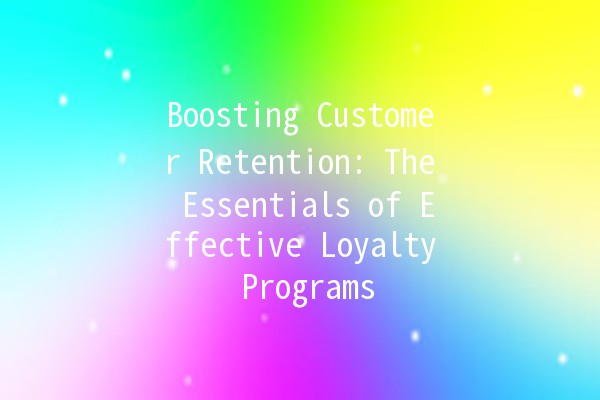In today's competitive market, businesses are continually seeking strategies to retain customers and enhance their shopping experiences. One of the most powerful tools at their disposal is a wellstructured loyalty program. This article delves deep into the realm of loyalty programs, showcasing their significance and providing actionable tips to optimize them for maximum customer engagement and retention.
Understanding Loyalty Programs
A loyalty program is a marketing strategy aimed at encouraging repeat business by rewarding customers for their continued patronage. These programs can take various forms, such as pointsbased systems, tiered rewards, or exclusive member benefits. The goal is to create a winwin situation where customers receive tangible rewards for their loyalty, while businesses enjoy increased sales and customer retention.
Why Are Loyalty Programs Important?

Five Productivity Boosting Tips for Effective Loyalty Programs
Explanation: Customizing loyalty programs to meet individual customer needs can significantly enhance engagement. This involves using customer data to tailor rewards and communication strategies.
Application Example: A coffee shop might track the purchasing habits of its customers and offer a free drink to customers who frequently buy a specific beverage. Email campaigns can include personal greetings and recommendations based on past purchases, leading to more targeted promotions.
Explanation: With the increasing reliance on smartphones, integrating mobile technology can streamline the experience for customers enrolled in loyalty programs.
Application Example: Create a mobile app that allows customers to track their points in realtime, redeem rewards, and receive notifications about special promotions. A retail store can also implement a QR code system for easy point accumulation at checkout.
Explanation: Social media can act as a powerful platform for loyalty programs to enhance customer interaction and engagement. Encouraging customers to share their experiences can yield significant benefits.
Application Example: Implement a referral program where customers receive bonus points for sharing their loyalty program on social media. Also, celebrate customer milestones online (e.g., their anniversary with your brand) to build community and connection.
Explanation: Setting achievable goals for rewards is crucial in keeping customers motivated and engaged. If rewards appear difficult to obtain, customers may lose interest.
Application Example: Instead of requiring thousands of points to redeem a reward, offer small, attainable rewards that customers can achieve more frequently. For instance, giving a $5 discount after every 100 points can encourage ongoing participation.
Explanation: Regularly soliciting customer feedback allows businesses to understand what’s working and what isn’t in their loyalty programs. Adaptation is key to keeping the program relevant and appreciated by users.
Application Example: Send out periodic surveys asking for input on the loyalty program. Use this information to make adjustments, such as changing the rewards or the methods by which points are earned, based on user preferences.
Frequently Asked Questions
Loyalty programs can generally be categorized into a few main types:
PointsBased Systems: Customers accumulate points based on their spending, which can be redeemed for rewards.
Tiered Programs: Customers achieve different loyalty levels (e.g., silver, gold, platinum), with each level providing increasing benefits.
Cashback Programs: Customers receive a percentage of their purchase back as cash or store credit.
Coalition Programs: Multiple businesses partner to offer rewards that customers can earn across various stores.
Monitoring the success of a loyalty program can be done through several key performance indicators (KPIs):
Enrollment Rates: The percentage of customers who register for the program.
Redemption Rates: The percentage of rewards that are claimed, indicating engagement levels.
Retention Rates: The number of repeat customers over a specified period.
Customer Lifetime Value (CLV): The predicted revenue that a business can make from the entirety of a customer's relationship.
Customer Feedback: Regular surveys can gauge customer satisfaction with the program itself.
Growing your loyalty program’s membership can be achieved through several strategies:
Incentives: Offering a signup bonus, such as immediate points or discounts.
Promotions: Announcing the program through marketing campaigns, highlighting benefits.
Accessibility: Ensure that customers can easily enroll at checkout, online, or via the app.
Staff Training: Train employees to inform customers about the program and its benefits effectively.
Yes, loyalty programs are incredibly effective for online businesses. They foster customer engagement in a digital landscape where facetoface interactions are absent. By using email or app notifications, online businesses can keep customers informed and engaged with their loyalty offerings.
Several brands have implemented successful loyalty programs that have significantly boosted customer retention:
Starbucks Rewards: Customers earn stars for every purchase and can redeem them for free drinks and food items.
Sephora’s Beauty Insider: Offers tiered benefits based on the customer’s spending, which includes birthday gifts and exclusive access to sales.
NORDSTROM’s Loyalty Program: Isn't focused solely on points; it offers exclusive services, personalized experiences, and early access to sales.
It’s crucial to review and update your loyalty program regularly, typically every 6 to 12 months. Changes should be based on customer feedback, industry trends, and your business objectives. Regular updates keep the program fresh and aligned with customer expectations.
, effectively managing a loyalty program is a multifaceted endeavor that requires attention to customer preferences, an understanding of emerging technologies, and ongoing adaptation based on feedback. Brands that successfully implement these strategies can build stronger, lasting relationships with their customers, enhancing retention, and ultimately driving greater sales growth.